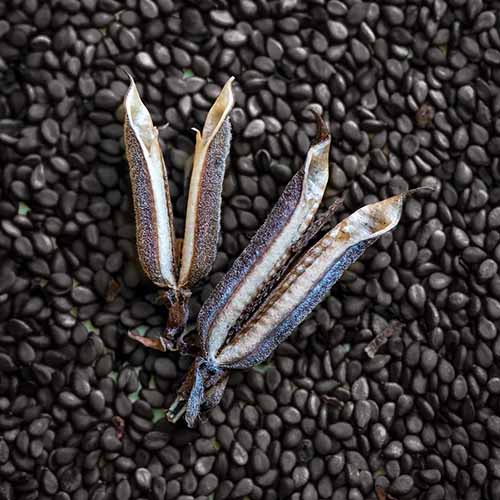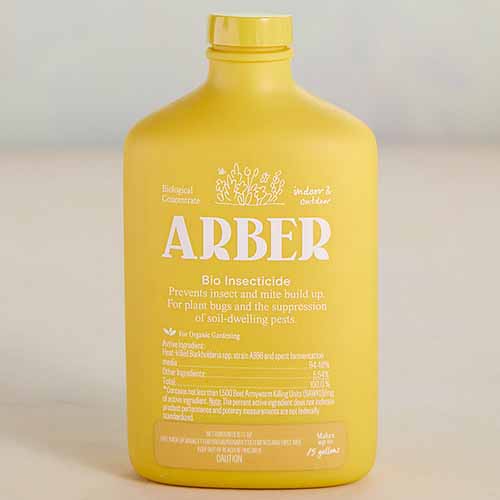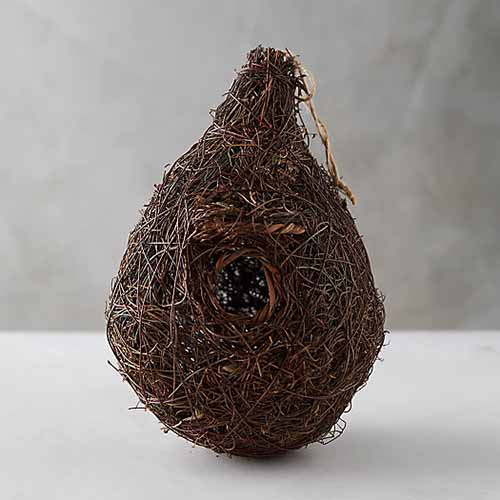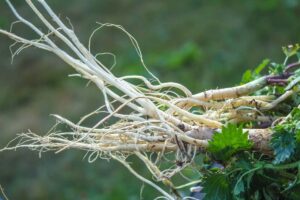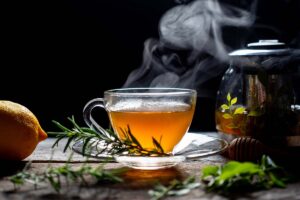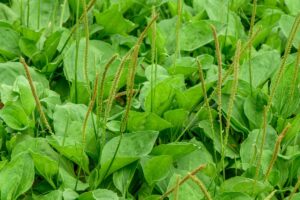Sesamum indicum
Sesame is one of the most ancient cultivated crops, and it may be the first seed that was grown for oil.
The tiny nutrition-packed seeds carry a robust nutty flavor enhanced by lightly toasting them.
Sesamum indicum is responsible for the existence of many mouth-watering dishes, as well as snacks and desserts, in kitchens across the globe. Many people are familiar with sesame’s culinary use but have never seen the plant.
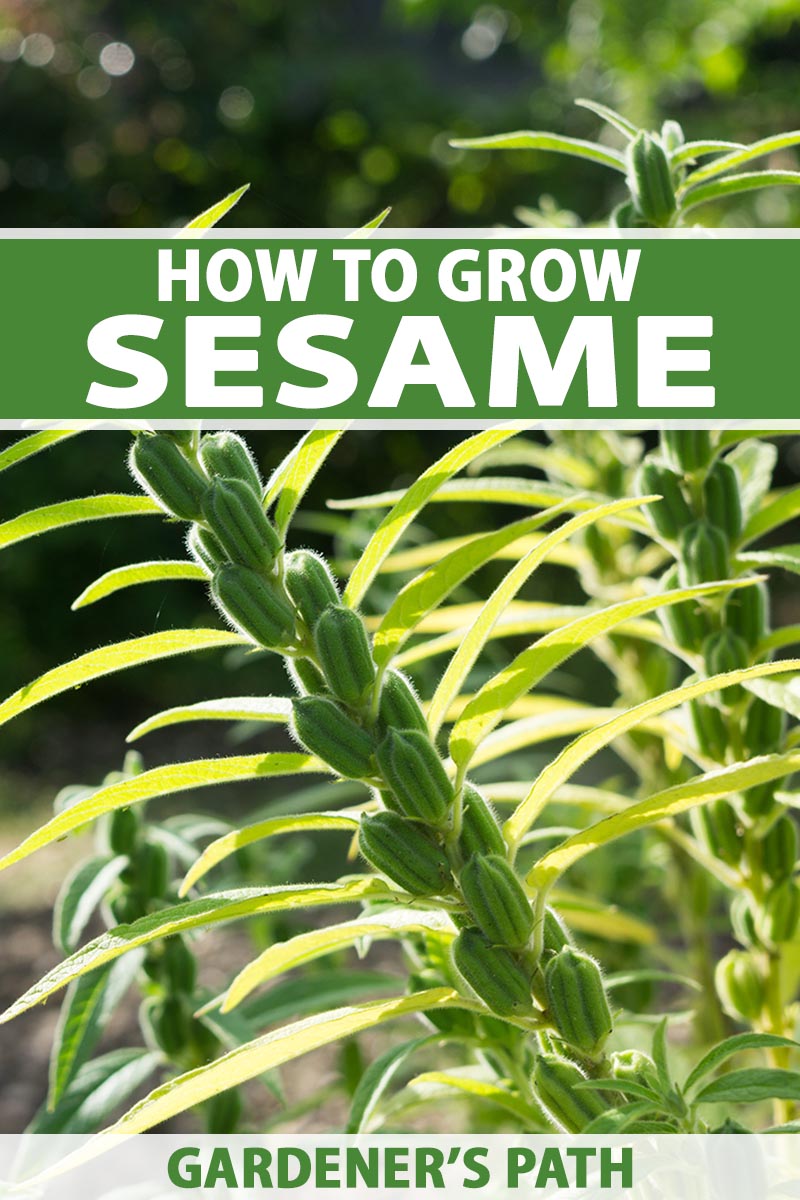
We link to vendors to help you find relevant products. If you buy from one of our links, we may earn a commission.
When you realize what a powerhouse S. indicum is, you’ll want to grow some in your garden! And if you’re into cultivating drought-tolerant edibles, this is an excellent choice.
Choosing plants like this annual species is a logical garden design approach in the wake of climate change. It thrives in dry conditions and grows wild in deserts.
An exceptional selection for xeriscaping and pollinator gardens, given the right conditions, they will reseed readily, providing a continual supply of seedlings.
On top of flourishing in harsh environments, they also provide a high concentration of nutrients and are considered a healing remedy in many cultures.
Ready to get started? Here’s everything we’ll cover up ahead:
What You’ll Learn
You may not be able to grow enough in a garden to make a jar of tahini, but you can certainly cultivate a sufficient supply to enjoy as a spice that is used in various ways.
Continue reading to learn about sesame’s rich history and how to grow this spice cabinet staple!
Cultivation and History
The genus Sesamum includes 23 species, and S. indicum is the most well-known and widely cultivated of these. Part of the Pedaliaceae family, this species is native to the Indian subcontinent.
An annual classified as an herb, it was first cultivated about four and a half millennia ago!
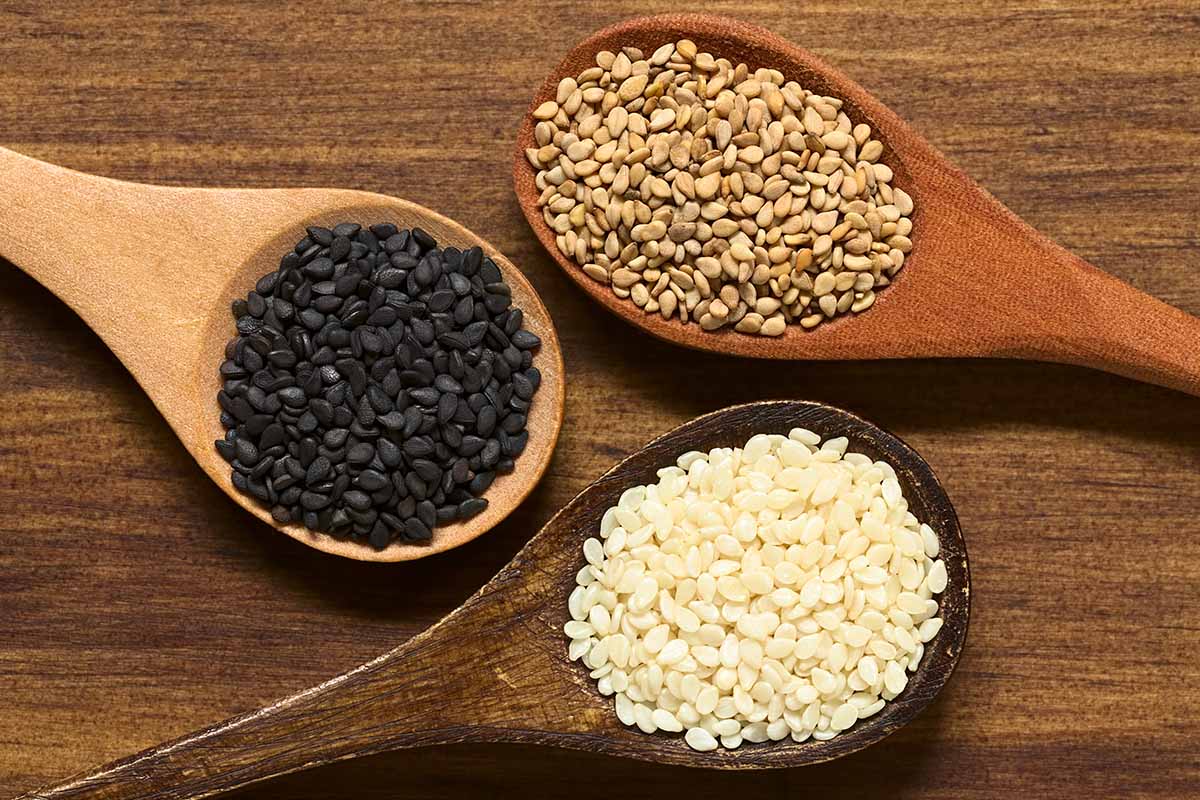
The seeds’ coat color comes in various shades, from red, yellow, and beige to brown or black.
The trumpet-shaped, pollinator-friendly flowers can be white, light pink, or light purple, and are shockingly gorgeous. Lush green leaves grow opposite each other on a central stem.
S. indicum grows in Zones 7 to 10. They like it hot!
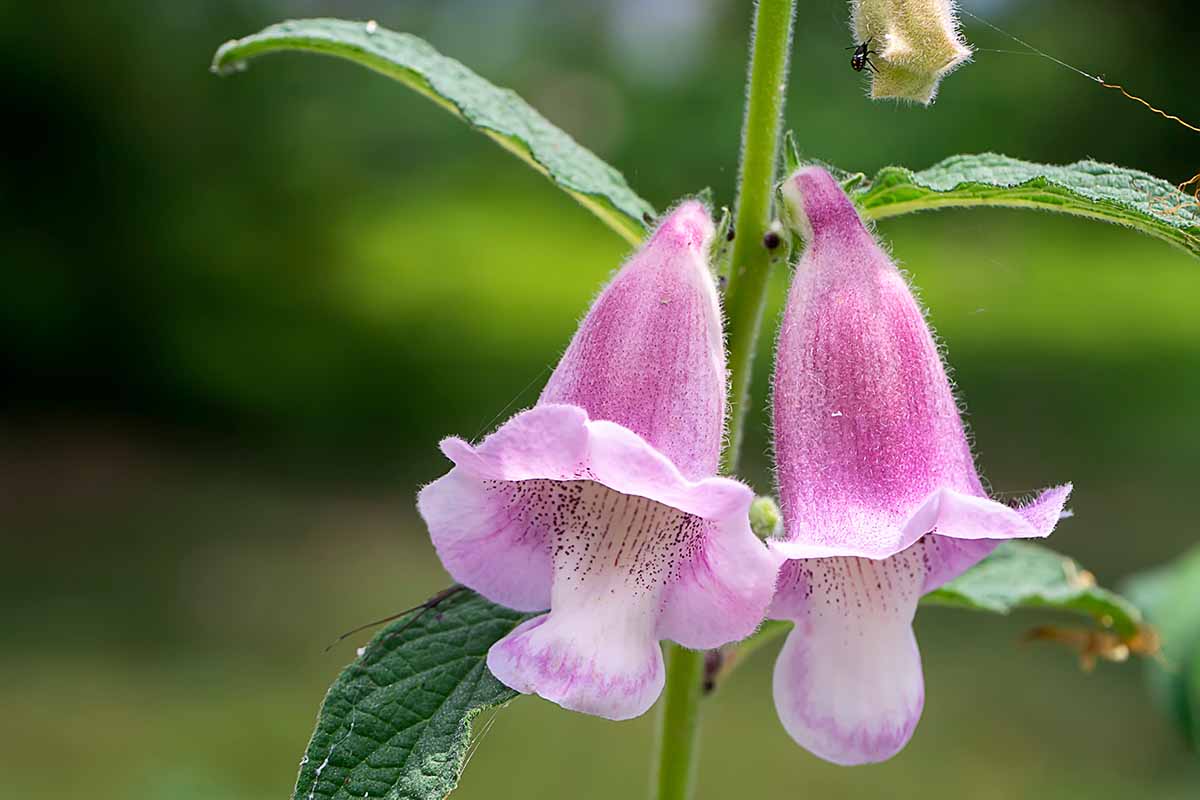
Sesame seeds were spread through trade networks to Mesopotamia from the Indian subcontinent by 2000 BCE and reached Egypt in 1500 BCE.
They are highly valued in China, particularly the black variety, and sesame was a commonly cultivated crop in China by 200 BCE.
Diverse varieties are available thanks to sesame’s ability to adapt to various environments. Most of the genetic diversity comes from China, Central Asia, Southwest Asia, India, and Ethiopia.
Many varieties from China spread into Central Asia through the ancient trade route commonly known as the Silk Road.
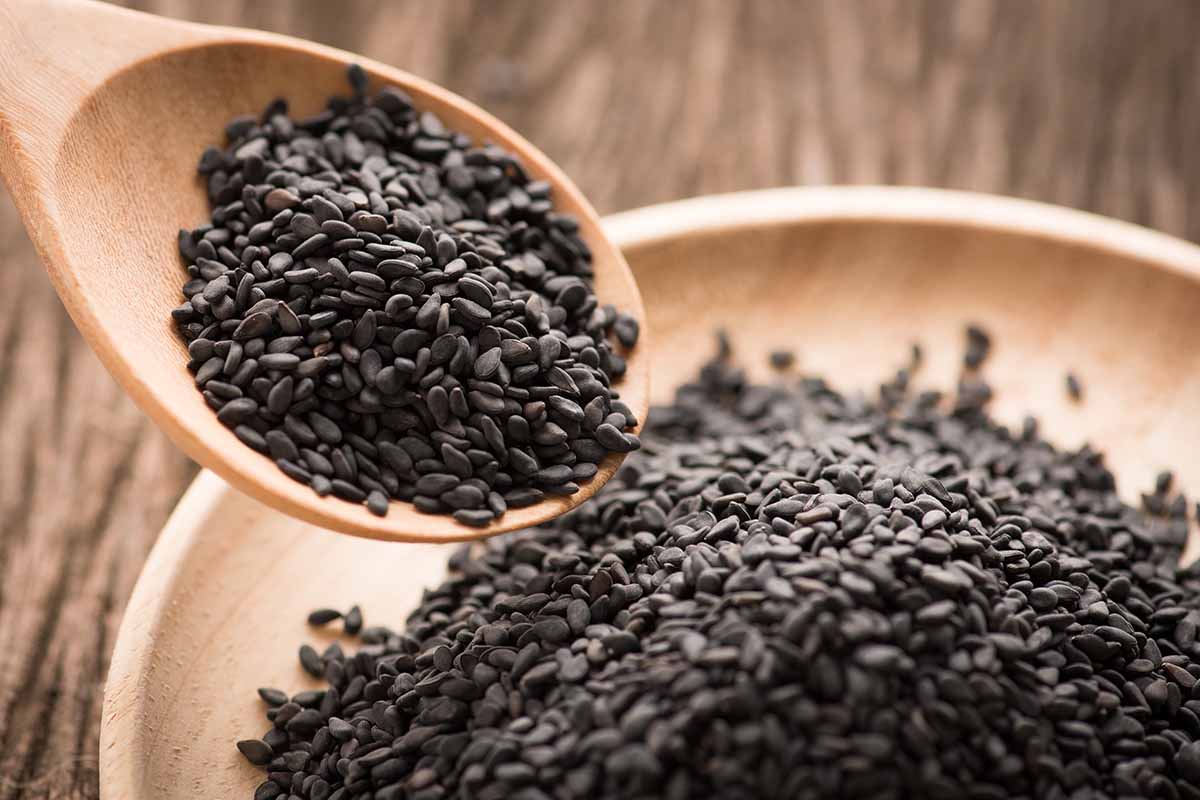
Black sesame seeds, also known as semen sesami nigrum or hei zhi ma, are mentioned in the ”Compendium of Materia Medica,” the largest and most comprehensive work of medical writing in traditional Chinese medicinal history, dating to the time of the Ming Dynasty.
Aside from being used as medicine, they are also popular in Chinese, Japanese, and Korean cooking.
India is currently the number one producer of sesame seeds in the world, and these go by many different names. In India they’re known as til and gingli in Hindi and tal in Gujarati. They are used in various dishes, baking, and candy recipes.
The seeds are deeply weaved into the culture and rituals of India, and the benefits they provide for the heart are described in ancient Hindi proverbs.
The oldest archaeological record of sesame seeds comes from the Indus Valley site at Harappa, in an area of Punjab that is now recognized as part of Pakistan. Their domestication and use has deep roots in Southwest Asian culture.
Tahini, the popular and tasty condiment made from them, is of Southwest Asian and North African origin.

Several wild sesame relatives are native to Africa, where the seeds are known as benne.
The entire plant is used in African cuisine and traditional medicine. Benne is considered a sign of good fortune in West Africa and given as offerings. Throughout Africa, planting benne is to grow good luck!
The first benne seeds made their way to America via enslaved Africans, who were the first to cultivate the plant in the US.
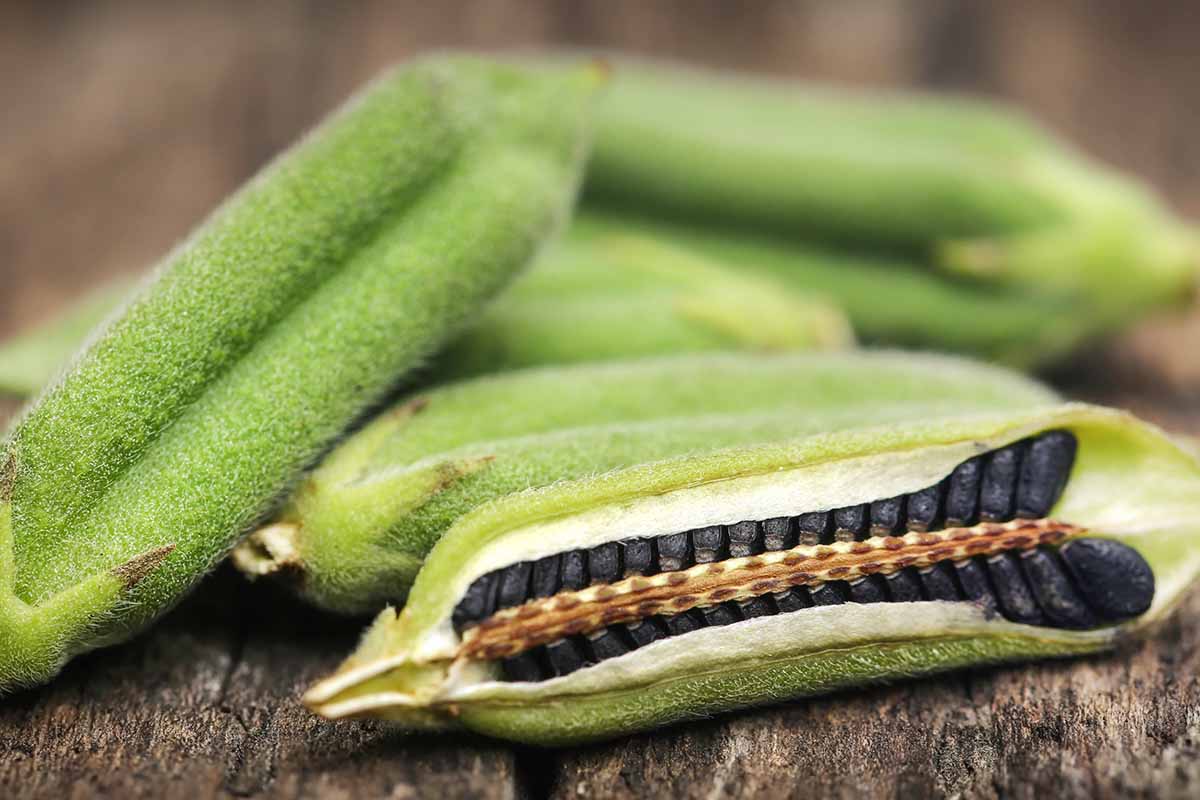
Commercial cultivation in the US has not grown significantly, though Americans are one of the most significant consumers of the spice, which is mainly imported from Mexico.
A large producer of sesame seeds, the spice is also a staple in many traditional Mexican dishes. In Spanish, they are called ajonjolí, derived from the Arabic jaljala, which translates to “sound echo” in English, in reference to the seeds’ sound within the pods when they are rattled.
The diverse use of these seeds adds to the appeal of planting them!
Propagation
S. indicum is exceptionally easy to grow from seed.
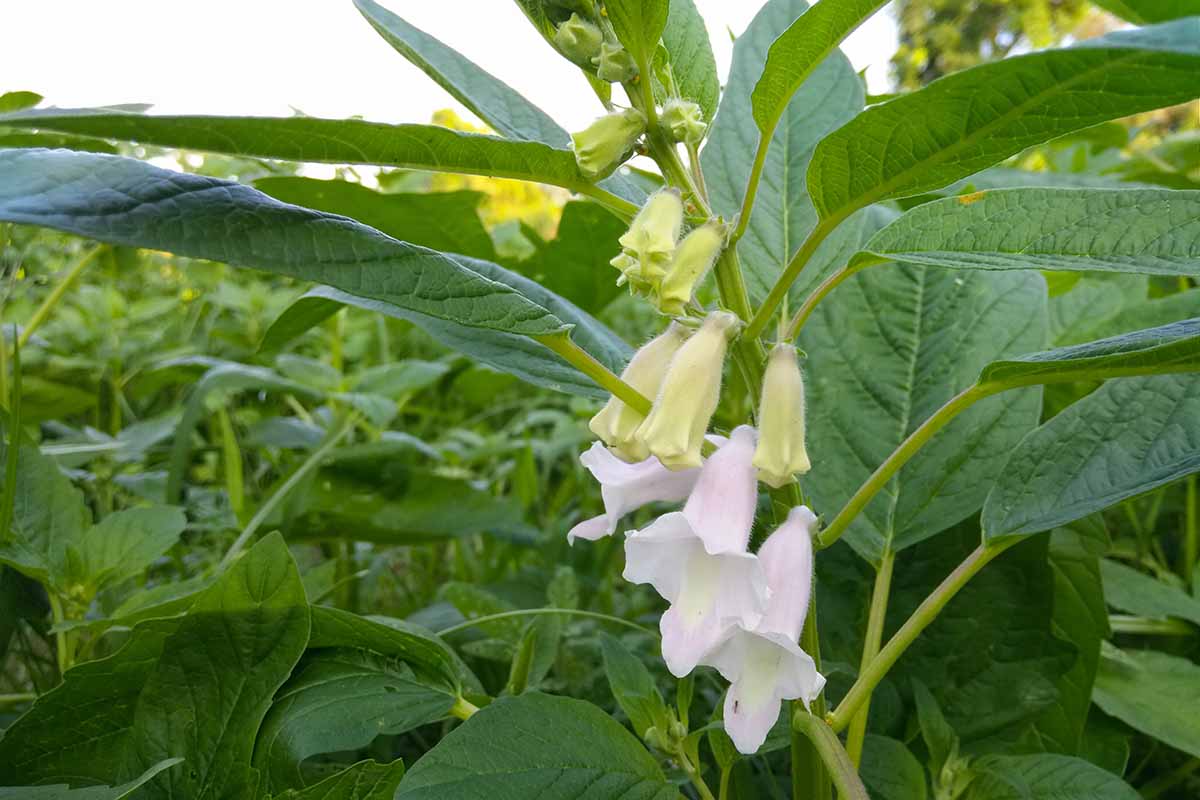
Drought-tolerant and forgiving of poor soil, their tubular blooms look like foxglove flowers, with their color slightly varying depending on the cultivar.
This water-wise flowering annual also supports ecosystems by attracting pollinators.
From Seed
If you are gardening in an area that experiences frost, sow seeds indoors four weeks ahead of your last frost date.
Plant seeds no more than a quarter of an inch deep in starting pots or seed trays filled with moist potting soil. Sow one seed per cell or space them two to three inches apart in trays.

Place your seed trays or starting pots in a location that receives full sun and maintain even soil moisture until they germinate. Your seeds will germinate in six to eight days when temperatures are in the mid-70s.
If directly sowing seeds outdoors, it’s recommended to plant them when daytime and nighttime temperatures are consistently above 65°F.
You can transplant your seedlings when their first true leaves emerge, which should happen in less than a month.
From Seedlings and Transplants
It’s best to plant seedlings or transplants outdoors in late spring or early summer once daytime temperatures are between 68 and 75°F.
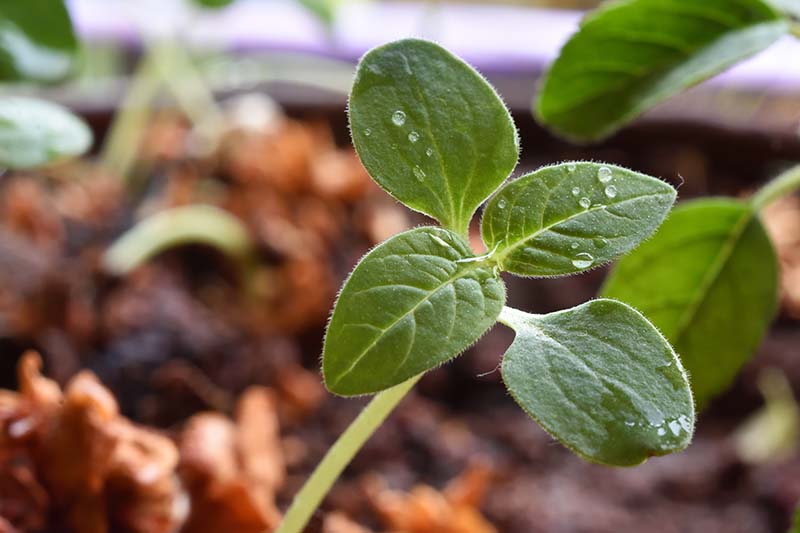
Select an area that receives full sun, and space plants one to two feet apart.
Dig a hole a little larger than the size of the root system. Place the plant in the hole, filling the bottom in with soil as needed to bring the base of the plant’s stem to soil level.
Fill the sides with soil, tamp down, and water weekly in the absence of rain until they are established.
How to Grow
Full sun is essential, and these plants prefer a pH range of 5.0 to 8.0. They can tolerate poor soils but also benefit from growing in organically rich soil.

Once plants are established, they don’t need much water. It’s important to remember not to grow plants that need a lot of water next to sesame.
Drainage is essential for these plants to thrive, and they should not be grown in soil that becomes waterlogged.
From the time when the plants start flowering in late summer, you can gather seed pods once they have fully matured. This can take up to 100 days.
Growing Tips
- Plant in well-drained soil and select a sunny spot for plants to thrive.
- Provide 2-3 feet of space between plants to encourage proper airflow.
- Provide adequate water for seedlings but do not overwater.
Cultivars to Select
There are a number of named S. indicum cultivars, though they are often simply listed as black or white sesame. Cultivars share the same growth habit and cultivation requirements as the species plant.
You can purchase generic, species-variety sesame seeds in packets of 500 from Burpee.
‘Kurogoma’ black sesame seeds are used to make Japanese black sesame ice cream and for use in making sushi. This variety is said to be highly aromatic and packed with flavor – a tasty selection to consider!
‘Black and Tan’ heirloom sesame seeds are a great variety to select if you have difficulty deciding what type to grow, since you get two colors with this delicious selection.
Managing Pests and Disease
It’s not common for sesame to experience pest damage or disease, especially in smaller gardens filled with biodiverse species to support a balanced ecosystem.
However, there are some insects and diseases that you should be aware of so you can practice good prevention.
Insects
The main insects that may affect the growth of these plants are the leaf webber, gall fly, and sesame leafhopper, which we’ll cover in a bit more detail below.
If these pests pose a problem, you can purchase a bioinsecticide like this one from Arber, which is available via Terrain.
It uses a beneficial fungal pathogen (Burkholderia spp. strain A396) and spent fermentation media to kill pests, and each bottle contains enough concentrate to mix 15 gallons of insecticide.
Keep in mind that if you decide to use a bioinsecticide, you could be killing caterpillars that turn into pollinating moths in the process. Apply with caution, and according to package labels.
Leaf Webber
The larvae of the leaf webber, Antigastra catalaunalis, pupate in webs. They use their webs to fuse leaves, flowers, or pods together where they then feed on the plant parts. Early infestations can lead to plant death.
Eggs are laid in clusters of about 10 and are cream-yellow colored. The larvae that hatch out are small green caterpillars that have black spots. Collect and destroy any larvae you notice.
You can also encourage birds to visit your garden to act as natural predators by including a birdhouse like this natural-looking brushwood option that’s available from Terrain.
Gall Fly
Look out for this pest when buds start to form. Stems will begin to show ball-shaped swellings. The maggots of Asphondylia sesami feed inside the flower buds, forming a gall-like growth that does not develop into a flower.
To manage this pest, clip off the galls and get rid of them. If gall flies persist, you can spray a bioinsecticide on the plant right before the flowers begin to develop.
Leafhopper
The disease known as phyllody is transmitted through Orosius albicinctus, which makes this type of leafhopper a serious pest.
Leafhoppers, or jassids, suck sap from the tender parts of plants. Damaged plants may exhibit curling leaf edges which then turn red or brown, eventually drying and dying.
If you notice an infestation, apply a bioinsecticide according to package instructions.
Disease
Given the right growing conditions, diseases are uncommon in sesame plants, but some ailments have been known to affect them in commercial cultivation.
The main diseases are phyllody, dry root rot, phytophthora blight, and Alternaria blight.
The best way to prevent these diseases is to practice proactive garden maintenance by picking up any foliage or debris that could encourage the spread of disease pathogens.
Do not spray or splash water on the leaves. Ensuring a quality soil source that’s free of disease is helpful, and sanitizing seed trays and planting containers before you plant is essential.
Alternaria Blight
Alternaria is a seed-borne pathogen that favors high humidity. The fungi will attack all parts of the plant at all stages, and tends to spread more rapidly in early to midsummer.
Also known as leaf spot, symptoms are exactly what they sound like – spots that are yellow to brown in color, which typically appear first along the leaf’s mid-vein.
Practice crop rotation to avoid a buildup of alternaria in the soil.
Remove infected plant material and spray regularly with a biofungicide to prevent further spread.
Dry Root Rot
The soilborne fungus known as Macrophomina phaseolina most commonly affects seedlings.
Young stems become stressed and exhibit water-soaked stems, and they are incapable of maturing. Toss affected seedlings out and start over by sanitizing your seed starting trays and using fresh soil.
This pathogen survives and is spread through soil and seed. Increased soil moisture combined with high temperatures makes for the perfect conditions this pathogen favors.
To help prevent this disease, do not overwater. Be sure to plant in well-draining soil or containers with appropriate drainage holes.
Phyllody
This disease is transmitted by leafhoppers, and it can affect yields. Phyllody causes leaves and flower tips to be malformed.
If the infection is severe, flowers will not form fully. Instead, short leaves that twist will gather closely on the stem, with branches also exhibiting abnormal growth.
The key to preventing this disease is to manage leafhopper populations.
Phytophthora Blight
Phytophthora nicotianae is a soilborne pathogen that favors high moisture and Phytophthora blight disease can occur at all stages of plant growth.
The first sign of disease is brown spots that turn to black on water-saturated leaves and stems. Leaves will then begin to fall prematurely.
Remove all fallen leaves from your growing space and pull infected plants out. Dispose of all affected plant parts.
Humid weather can support the spread and severity of this disease, which can also affect the roots.
Ensuring good airflow between plants and proper water management will help to prevent this disease from affecting your harvest.
Harvesting and Storage
A fantastic trait of sesame is that you can harvest seed pods while the plant continues to flower and produce more. The seed pods will develop first at the bottom of the plant while the top remains in bloom. Each pod will give you sixty to eighty seeds!
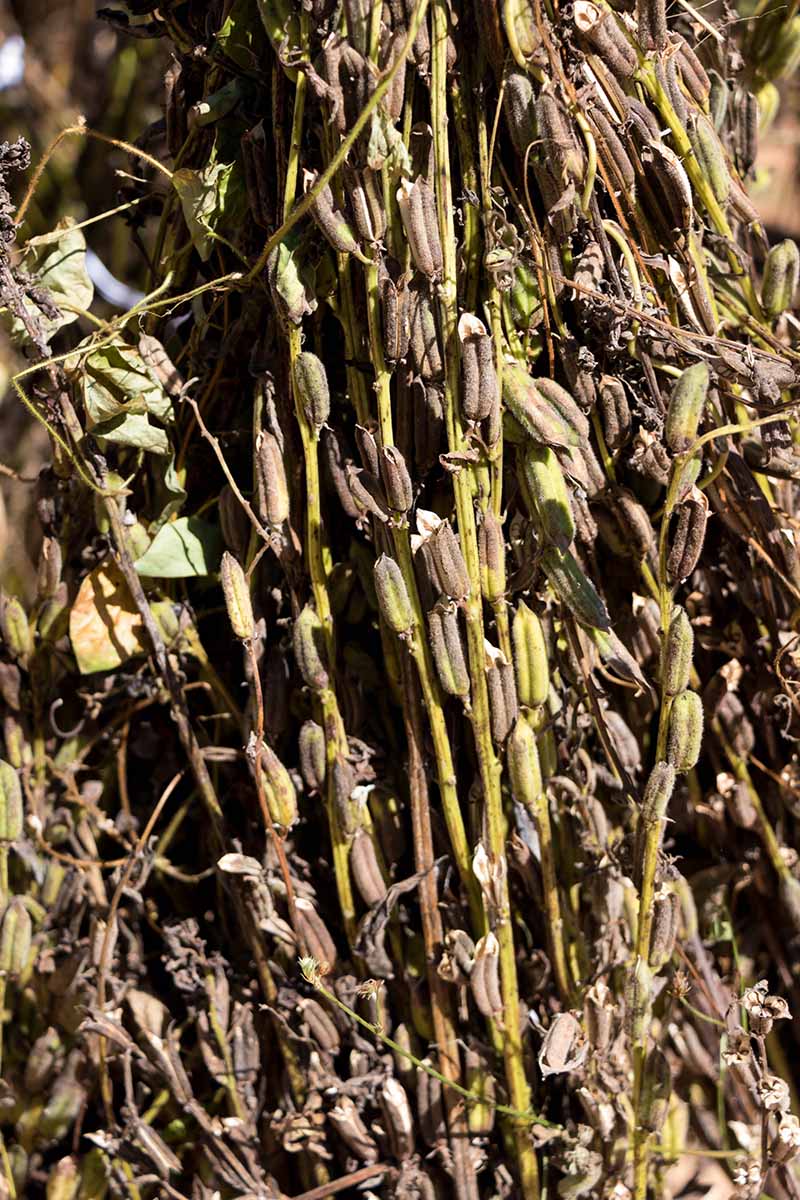
Since the seed pods pop open when they mature fully, you can place them in paper bags to prevent losses.
Give the bag a few shakes every now and then, and open the bag to check on your pods. If they are fully dry but have not popped open, gently break up the pods to release them. To separate seeds from chaff, winnow them with a fan.
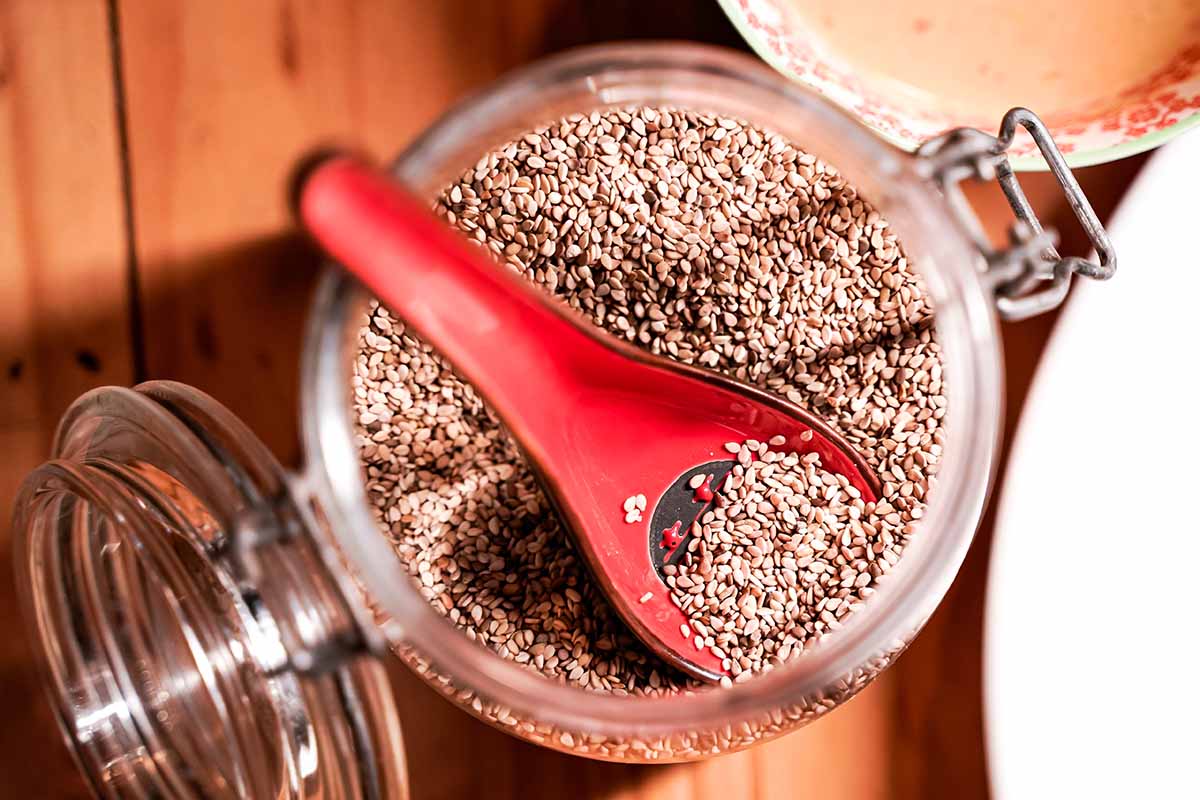
Once you’re done processing your dry seeds, store them away from direct light in an air-tight container or a spice jar. They will keep longer in the fridge, up to a year, and on the shelf they will last for up to eight months.
You can also freeze them, where they will keep for a year to 18 months.
Recipes and Cooking Ideas
Now that you have some yummy homegrown sesame seeds you can use them as toppings and in a myriad of recipes.
Since the harvest yield is not that substantial per plant, making tasty snacks like this maple-spiced nuts and seeds recipe from our sister site Foodal is perfect!
Maybe you want to make a larger dish to share that would be ideal for a potluck.
This purple cabbage and shaved asparagus slaw with cumin-sesame dressing, also on Foodal, gives you an excellent excuse to let people know that your dish has homegrown sesame seeds in it, which will surely start a conversation!
Quick Reference Growing Guide
| Plant Type: | Annual flowering herb | Water Needs: | Moderate |
| Native to: | Indian subcontinent | Maintenance: | Low |
| Hardiness (USDA Zone): | 7-11 | Tolerance: | Heat, drought, poor soil |
| Season: | Summer | Soil Type: | Organically rich |
| Exposure: | Full sun | Soil pH: | 5.0-8.0 |
| Time to Maturity: | 100 days | Soil Drainage: | Well-draining |
| Spacing: | 1-2 feet | Companion Planting: | Amaranth, beans, cherry tomatoes, and drought-tolerant annual wildflowers |
| Planting Depth: | 1/4 inch (seeds), depth of root ball (transplants) | Avoid Planting With: | Water-loving plants |
| Height: | 3-4 feet | Family: | Pedaliaceae |
| Spread: | 2-3 feet | Genus: | Sesamum |
| Common Pests and Diseases: | Gall fly, leaf webber, sesame leafhopper; alternaria blight, dry root rot, phyllody, phytophthora blight | Species: | Indicum |
Spice Up Your Garden with Sesame
I won’t be surprised if the cultivation of sesame seeds in gardens increases as droughts continue and the climate continues to warm.
The amount of nutrition they provide from what they receive during their growth cycle exceeds expectations. No wonder so many cultures honor sesame as a sacred seed through rituals and recipes.

Aside from adding more spices to the kitchen, sesame also brings beneficial pollinators to gardens, providing a display of dancing bees that gardeners love to see.
Let us know if you’ve grown sesame before or have any questions in the comments section below. We love hearing about your experiences and helping to provide you with garden guidance!
Want to add more spice to your garden? Check out these articles next for more easy-to-grow pollinator-friendly herbs to help you build your spice cabinet:
